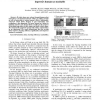261 search results - page 9 / 53 » Theory and Evaluation of Human Robot Interactions |
HRI
2009
ACM
14 years 2 months ago
2009
ACM
Autonomous robots tend to induce the perception of a personality through their behavior and appearance. It has been suggested that the personality of a robot can be used as a desi...
BCSHCI
2008
13 years 9 months ago
2008
Computing technology is now so entwined with everyday life that enquiries into human computer interaction (HCI) are also studies of society and culture Cultural and Critical theor...
HRI
2007
ACM
13 years 11 months ago
2007
ACM
We present a new technique for human-robot interaction called robot expressionism through cartooning. We suggest that robots utilise cartoon-art techniques such as simplified and ...
HRI
2010
ACM
13 years 9 months ago
2010
ACM
If robots learn new actions through human-robot interaction, it is important that the robots can utilize rewards as well as instructions to reduce humans' efforts. Additionall...
HRI
2009
ACM
14 years 2 months ago
2009
ACM
This paper investigates the potential usefulness of viewing the system of human, robot, and environment as an “information pipeline” from environment to user and back again. I...

